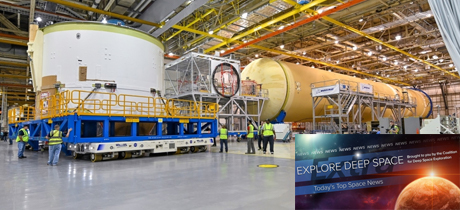In Today’s Deep Space Extra… The assembly of the first Space Launch System (SLS) core stage moves ahead. The fate of India’s efforts to soft land a spacecraft on the Moon, Chandrayaan-2 suggest once again that landing on the Moon will be a challenge for NASA and its commercial and international partners.
Human Space Exploration
Turning the SLS engine section over for final core stage mate
NASAspaceflight.com (9/9): A look at how NASA’s Space Launch System (SLS) core stage prime contractor, Boeing, will complete the horizontal assembly of the first stage for Artemis 1, the first joint test launch of the SLS and Orion crew capsule on an uncrewed, multi week flight around the Moon and back to Earth.
FAA: No further assessment needed for SpaceX testing
Brownsville Herald of Texas (9/9): The FAA has determined that no further Environmental Impact Studies of SpaceX will be required, though the company’s focus of activities at its south Texas site, Falcon 9 rocket launches, has changed since the initial EIS was completed in 2014. More recently, activities at Boca Chica have turned to development of Starship, part of a commercial heavy lift rocket for transporting humans to Mars.
Backing NASA’s human spaceflight program could help Democrats win back the White House
Forbes (9/9): Winning Florida’s electoral votes could be crucial to the outcome of the 2020 presidential election. So far, candidates on the Democratic side have not expressed enthusiasm for NASA’s efforts to return human explorers to the Moon on an accelerated 2024 schedule, a potential factor in sunshine state balloting, where space commerce is an economic factor.
Astronauts make first cement in space to support future Martian habitats
Space.com (9/9): Astronauts working aboard the International Space Station (ISS) recently demonstrated a first, the formulation of cement into concrete in the absence of gravity, a potentially significant step in the construction of structures on the Moon and Mars that could shelter human explorers from space radiation. A next step is to assess whether the soil and rocks of the Moon and Mars could substitute for the gravel of Earth in the concrete mix.
Space Science
NASA praises India’s mission, wants joint exploration of solar system
Times of India (9/8): NASA has offered India praise for its inspirational efforts to soft land on the Moon with the Chandrayaan-2 mission, despite what appears to have been a hard landing and loss of contact of contact with the Vikram lander. NASA expressed interest in future joint operations with the Indian Space Research Organization (ISRO).
Schrödinger’s lander
The Space Review (9/9): There are lessons to be learned from India’s loss of communication with the Chandrayaan-2 Vikram lander as it attempted to descend to the lunar surface for a soft landing last Friday and the loss in April of Israel’s Beresheet lander, as it too attempted to land without success. The fate of India’s lander is unclear, and the India Space Research Organization (ISRO) has been slow to update its fate other than to disclose that the Chandrayaan-2 orbiter has acquired imagery that shows the lander intact but tilted. Landing on the Moon is difficult, and even private companies like those participating in NASA’s Commercial Lunar Payload Services program need to be open about their missions, writes TSR editor Jeff Foust.
New models suggest Titan lakes are explosion craters
NASA Jet Propulsion Laboratory (9/9): Earlier this year, NASA announced plans for a drone mission called Dragonfly to Titan, the moon of Saturn with an atmosphere and where methane and ethanol flow like water in a very cold environment. However, NASA’s Cassini mission, which orbited Saturn until its mission ended two years ago, also observed Titan and the data have offered a theoretical explanation for small bodies of liquid methane on the Moon. Pockets of liquid nitrogen in the crust may have warmed enough to blow out, leaving a crater that filled with the liquid. Scientists published the theory in the journal Nature Geosciences.
Other News
NASA Langley gets a new director
The Daily Press of Hampton, Virginia (9/9): NASA Administrator Jim Bridenstine on Monday announced the appointment of Clayton Turner as director of the Langley Research Center. Formerly Langley’s deputy director and an engineer, Turner succeeds David Bowles, who is retiring with plans to join Old Dominion University and the new Virginia Institute for Spaceflight and Autonomy.
A diversified space portfolio (Op Ed)
The Hill (9/10): National investment in space exploration should not involve choosing incumbents versus new entrants. Instead, our national investment should follow the basics of good portfolio management – diversification. Engaging familiar and new companies will be vital to the long-term success of our nation’s space program.
Backing NASA’s human spaceflight program could help Democrats win back the White House (Op Ed)
Forbes (9/9): Winning Florida’s electoral votes could be crucial to the outcome of the 2020 presidential election. So far, candidates on the Democratic side have not expressed enthusiasm for NASA’s efforts to return human explorers to the Moon on an accelerated 2024 schedule, a potential factor in sunshine state balloting, where space commerce is an economic factor.
United States Space Command formally relaunched
Washington Times (9/9): The United States Space Command was formally relaunched in ceremonies Monday at the Pentagon. Its mission is to protect the nation’s space national security, especially from rising threats posed by China and Russia.
This is what happens when two satellites collide in space
Vice (9/9): The low Earth orbit satellite population stands at about 1,300 active spacecraft, among them the six person International Space Station (ISS). But the number could increase dramatically with plans for constellations of small satellite to provide internet connectivity and Earth observations. The collision of any two can create even more man made material in space in the form of debris that could claim even more satellites with high speed impacts. Finding a way to manage the traffic in low Earth orbit is an increasing challenge.

